Used on a variety of scales, PIV has proven to be reliable and effective both in industrial and academic research by facilitating optimal designs of processes and machine parts as well as allowing to investigate new physics of flowing fluids.
Flow problems set at a scale of individual reservoir rock pores employ PIV at microscopic scales (μPIV). A μPIV experiment consists of seeding a flowing liquid with special fluorescent particles (tracers) and capturing pairs of images of the flow while simultaneously illuminating it with pulses of laser light. The pairs are then analyzed to deduce how the particle distribution changes from one image to the other. A cross-correlation algorithm is used to construct velocity fields at each point of the seeded fluid. Researchers can then analyze the transient behavior of the velocity fields in complex porous media using multiple pairs of images.
The research conducted at the COIFPM allows for enhanced prediction capabilities of pore-network flow models of rocks. Advances in the understanding of dynamics of fluid-displacement processes allow for the continued fine-tuning of models to better fit and predict experimental data. μPIV has the power to unveil dynamics at these miniature scales. Improved pore-scale models can then be used to test certain reservoir treatments (e.g. low-salinity waterflooding, CO2 sequestration and an array of others) in order to gauge its effectiveness prior to large-scale implementation. This means more effective decision-making, and ultimately higher and more efficient oil recovery.
GALLERY



